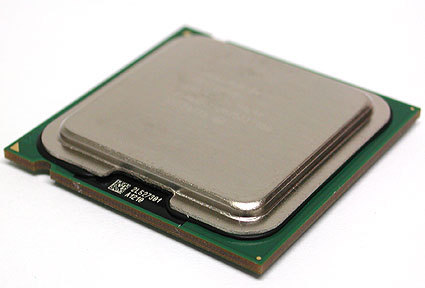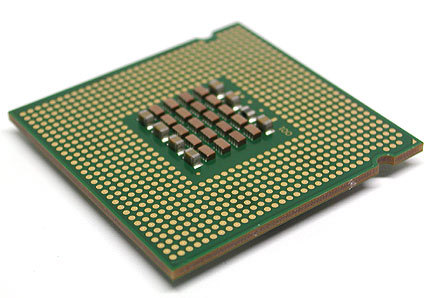A 4.1 GHz Dual Core at $130 - Can it be True?
Inside the Pentium D 805
The Pentium D 805 is based on the first Intel dual core processor, the Pentium D with the Smithfield core. Its predecessors in this family were rated at clock speeds of 2.8 GHz (D 820) to 3.2 GHz (D 840). Both cores in this CPU family come equipped with a 1 MB L2 cache, whereas the most current dual core processors in the 900 series make 2 MB available to each core. For the last year, Intel has brought no new models in the 800 series to market, because the company has switched its fabrication from a 90 nm process to a 65 nm one in the meantime, and has used this smaller building block size only for processors in the 900 series. But then out of nowhere, the old Smithfield core put in another appearance in the form of the Pentium D 805.
The Intel Pentium D 805 costs only $130 but incorporates a dual core - only a few users were in the know about this.
A rear view of the Pentium D 805, built for the LGA 775 socket.
| Processor | Number | Clock Speed | L2 Cache | Multiplier | FSB clock |
|---|---|---|---|---|---|
| Pentium EE | 965 | Dual 3724 MHz | 2 MB | 14x | 266 MHz QDR |
| Pentium EE | 955 | Dual 3466 MHz | 2 MB | 13x | 266 MHz QDR |
| Pentium D | 950 | Dual 3400 MHz | 2 MB | 17x | 200 MHz QDR |
| Pentium D | 940 | Dual 3200 MHz | 2 MB | 16x | 200 MHz QDR |
| Pentium D | 930 | Dual 3000 MHz | 2 MB | 15x | 200 MHz QDR |
| Pentium D | 920 | Dual 2800 MHz | 2 MB | 14x | 200 MHz QDR |
| Pentium 4 "E" | 661 | Single 3600 MHz | 2 MB | 18x | 200 MHz QDR |
| Pentium 4 "E" | 651 | Single 3400 MHz | 2 MB | 17x | 200 MHz QDR |
| Pentium 4 "E" | 641 | Single 3200 MHz | 2 MB | 16x | 200 MHz QDR |
| Pentium 4 "E" | 631 | Single 3000 MHz | 2 MB | 15x | 200 MHz QDR |
| Pentium EE | 840 | Dual 3200 MHz | 1 MB | 16x | 200 MHz QDR |
| Pentium D | 840 | Dual 3200 MHz | 1 MB | 16x | 200 MHz QDR |
| Pentium D | 830 | Dual 3000 MHz | 1 MB | 15x | 200 MHz QDR |
| Pentium D | 820 | Dual 2800 MHz | 1 MB | 14x | 200 MHz QDR |
| Pentium D | 805 | Dual 2666 MHz | 1 MB | 20x | 133 MHz QDR |
By comparison with all the other processors in this series, the D 805's relatively low clock speed of 2.66 GHz doesn't make much of an impression on store shelves. At 133 MHz (533 QDR), its front side bus clock rate is laughable when compared to state-of-the-art CPUs with 200 and 266 MHz speeds.
| FSB clock | Bandwidth |
|---|---|
| 266 MHz (1066 QDR) | 8.53 GB/sec |
| 200 MHz (800 QDR) | 6.40 GB/sec |
| 133 MHz (533 QDR) | 4.20 GB/sec |
Out of the box and with no additional modifications, the Pentium D 805 is not even half as fast at exchanging data with the Northbridge chipset, when compared to leading-edge CPUs with 266 MHz FSB clocks.
Get Tom's Hardware's best news and in-depth reviews, straight to your inbox.
Current page: Inside the Pentium D 805
Prev Page A Budget CPU At Top Speeds, Continued Next Page The Secret Of The MultiplierTom's Hardware is the leading destination for hardcore computer enthusiasts. We cover everything from processors to 3D printers, single-board computers, SSDs and high-end gaming rigs, empowering readers to make the most of the tech they love, keep up on the latest developments and buy the right gear. Our staff has more than 100 years of combined experience covering news, solving tech problems and reviewing components and systems.


